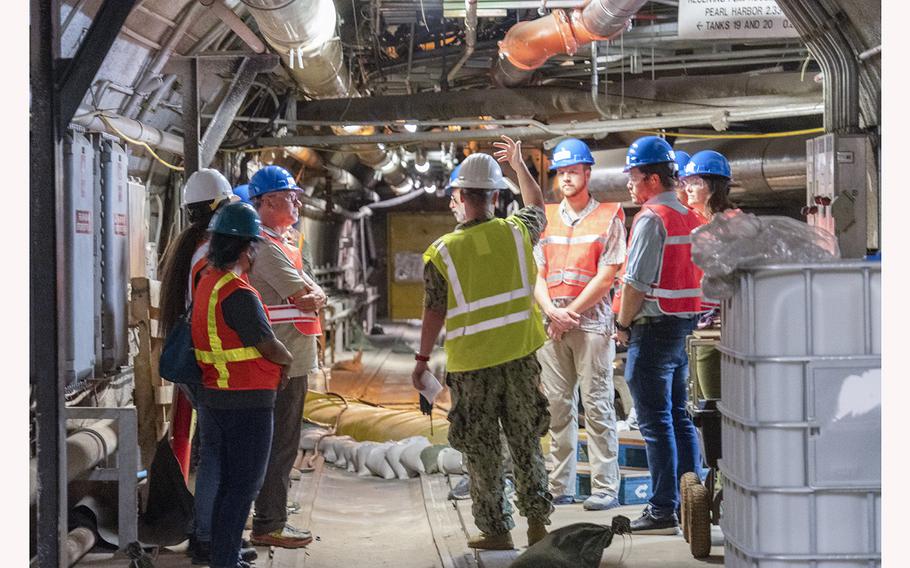
Navy Cmdr. Bill Jakubowicz, commander, Defense Logistics Agency Energy East Pacific, explains the layout of the Red Hill Bulk Fuel Storage Facility to U.S. Environmental Protection Agency and Hawaii Department of Health regulators during a site visit on Jan. 20, 2023. (Orlando Corpuz/U.S. Air Force)
(Tribune News Service) — The U.S. Environmental Protection Agency says it will grant the Navy’s request for more time to turn over information about spills of toxic fire suppression chemicals at its Red Hill underground fuel facility, but only if military officials agree to speed up release of some of the requested material.
The EPA’s law enforcement arm had given the Navy a Feb. 6 deadline to provide it with information about the cleanup and environmental remediation of 2022’s spill of aqueous film forming foam, or AFFF, at Red Hill, and any additional spills at the facility in past years. An estimated 1, 300 gallons of the foam concentrate, which is on hand in the event of a fuel fire, had spilled from a pipeline Nov. 29 at the beleaguered facility, raising concerns that dangerous chemicals in the suppressant, called PFAS, could eventually migrate into the aquifer that supplies much of Oahu’s drinking water.
The Navy, on the eve of the deadline, questioned the EPA’s legal authority to request the information but said it would provide it voluntarily and asked for an additional five weeks. A Navy spokesperson told the Honolulu Star-Advertiser at the time that a team was working to collect information not just about historic spills of AFFF at the Red Hill facility, but all of Joint Base Pearl Harbor-Hickam, which was why it was taking so long.
In a letter sent this week to Navy Rear Adm. Stephen Barnett, commander of U.S. Navy Region Hawaii, the EPA said it disagreed with the Navy’s assertion that the agency lacks the legal authority under the Resource Conservation and Recovery Act to require the Navy to provide the information. The Navy had argued that AFFF and its components were not classified as hazardous waste under the act. The EPA said this was not the case and that “delays in responding to the information request letter “ were impeding its investigation into the November spill.
Still, the EPA said it would give the Navy more time if it would provide the information in phases.
The Navy didn’t immediately say whether it would agree to the terms. A Navy spokesperson said Tuesday that Navy Region Hawaii had just received the letter and was reviewing it prior to responding to the EPA.
Under the EPA’s new terms, the Navy is required to turn over video of the AFFF spill and data related to Red Hill’s AFFF fire suppression lines during the period of Nov. 28 to Dec. 1. The Navy would be given until March 15 to provide the rest of the information, including descriptions of all past AFFF spills at Red Hill Bulk Fuel Storage Facility, maps of water utility infrastructure in the vicinity of releases and environmental remediation responses.
The Department of Defense is working to permanently close the Red Hill facility, following a fuel spill in 2021 that contaminated the Navy’s drinking water system and sickened military families. Part of that process includes shoring up the fire suppression system to ensure it’s safe to drain the approximately 104 million gallons of fuel stored in Red Hill’s underground tanks. The Nov. 29 AFFF spill occurred during maintenance and repair activities.
In other Red Hill developments, the Navy said this week that some of the soil samples taken in the vicinity of the Nov. 29 AFFF spill contained trace amounts of PFAS (per-and polyfluoro alkyl substances, known as “forever chemicals “ because they degrade so slowly in the environment ) that exceed the environmental action levels set by the EPA and state Department of Health. The Navy said it would coordinate with the regulatory agencies to determine whether further environmental remediation is required.
“The exceedances found indicated contamination in the low parts per billion range. Based on these low numbers, the exceedances represent a trace amount of contaminant in a large amount of soil, which indicate that most of the contamination was recovered and removed, “ a Navy spokesperson said.
(c)2023 The Honolulu Star-Advertiser
Visit The Honolulu Star-Advertiser at www.staradvertiser.com
Distributed by Tribune Content Agency, LLC.